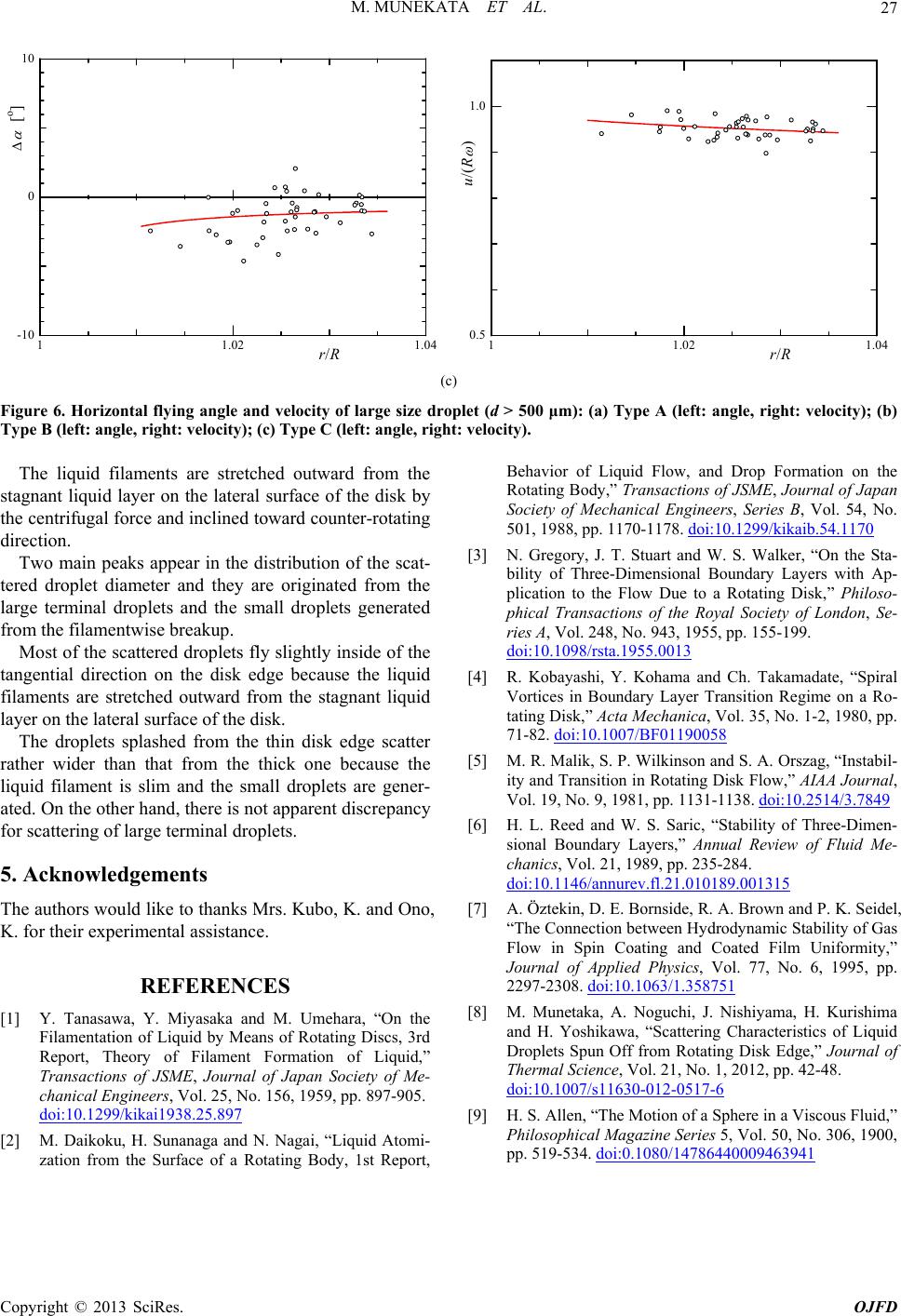
M. MUNEKATA ET AL. 27
11.02 1.04
r/R
-10
0
10
[
o]
11.02 1.04
r/R
0.5
1.0
u/(R
)
(c)
Figure 6. Horizontal flying angle and velocity of large size droplet (d > 500 μm): (a) Type A (left: angle, right: velocity); (b)
The liquid filaments are stretched outward from the
st
peaks appear in the distribution of the scat-
te
ly slightly inside of the
ta
isk edge scatter
ra
ks Mrs. Kubo, K. and Ono
REFERENCES
[1] Y. Tanasawa,Umehara, “On the
Type B (left: angle, right: velocity); (c) Type C (left: angle, right: velocity).
agnant liquid layer on the lateral surface of the disk by
the centrifugal force and inclined toward counter-rotating
direction.
Two main
red droplet diameter and they are originated from the
large terminal droplets and the small droplets generated
from the filamentwise breakup.
Most of the scattered droplets f
ngential direction on the disk edge because the liquid
filaments are stretched outward from the stagnant liquid
layer on the lateral surface of the disk.
The droplets splashed from the thin d
ther wider than that from the thick one because the
liquid filament is slim and the small droplets are gener-
ated. On the other hand, there is not apparent discrepancy
for scattering of large terminal droplets.
5. Acknowledgements
The authors would like to than,
K. for their experimental assistance.
Y. Miyasaka and M.
Filamentation of Liquid by Means of Rotating Discs, 3rd
Report, Theory of Filament Formation of Liquid,”
Transactions of JSME, Journal of Japan Society of Me-
chanical Engineers, Vol. 25, No. 156, 1959, pp. 897-905.
doi:10.1299/kikai1938.25.897
[2] M. Daikoku, H. Sunanaga and N. Nagai, “Liquid Atomi-
of Liquid Flow, and Drop Formation on the
zation from the Surface of a Rotating Body, 1st Report,
Rotating Body,” Transactions of JSME, Journal of Japan
Society of Mechanical Engineers, Series B, Vol. 54, No.
501, 1988, pp. 1170-1178.
Behavior
doi:10.1299/kikaib.54.1170
[3] N. Gregory, J. T. Stuart and W. S. Walker, “On the Sta-
bility of Three-Dimensional Boundary Layers with Ap-
plication to the Flow Due to a Rotating Disk,” Philoso-
phical Transactions of the Royal Society of London, Se-
ries A, Vol. 248, No. 943, 1955, pp. 155-199.
doi:10.1098/rsta.1955.0013
[4] R. Kobayashi, Y. Kohama and Ch. Takamadate, “Spiral
Vortices in Boundary Layer Transition Regime on a Ro-
tating Disk,” Acta Mechanica, Vol. 35, No. 1-2, 1980, pp.
71-82. doi:10.1007/BF01190058
[5] M. R. Malik, S. P. Wilkinson and S. A. Orszag, “Instabil-
ity and Transition in Rotating Disk Flow,” AIAA Journal,
Vol. 19, No. 9, 1981, pp. 1131-1138. doi:10.2514/3.7849
[6] H. L. Reed and W. S. Saric, “Stability of Three-Dimen-
sional Boundary Layers,” Annual Review of Fluid Me-
chanics, Vol. 21, 1989, pp. 235-284.
doi:10.1146/annurev.fl.21.010189.001315
[7] A. Öztekin, D. E. Bornside, R. A. Brown and P. K. Seidel,
“The Connection between Hydrodynamic Stability of Gas
Flow in Spin Coating and Coated Film Uniformity,”
Journal of Applied Physics, Vol. 77, No. 6, 1995, pp.
2297-2308. doi:10.1063/1.358751
[8] M. Munetaka, A. Noguchi, J. Nishiyama, H. Kurishima
and H. Yoshikawa, “Scattering Characteristics of Liquid
Droplets Spun Off from Rotating Disk Edge,” Journal of
Thermal Science, Vol. 21, No. 1, 2012, pp. 42-48.
doi:10.1007/s11630-012-0517-6
[9] H. S. Allen, “The Motion of a Sphere in a Viscous Fluid,”
Philosophical Magazine Series 5, Vol. 50, No. 306, 1900,
pp. 519-534. doi:0.1080/14786440009463941
Copyright © 2013 SciRes. OJFD